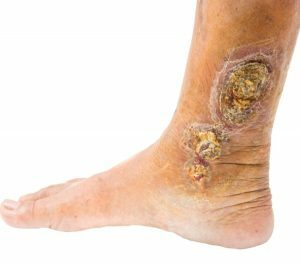 Vascular problems are common in elderly people and in very young people. Serious disorders of this type include lymphovenous( or venous-lymphatic) insufficiency.
Vascular problems are common in elderly people and in very young people. Serious disorders of this type include lymphovenous( or venous-lymphatic) insufficiency.
This disorder is characterized by irregularities in the processes of blood outflow from the veins. The disease can have both an easy and severe form of development.
Consider the causes and main symptoms of the disease, the methods of treatment and the basic preventive measures to prevent violations.
Contents of
- Who is at risk of getting sick?
- How does the disease manifest itself?
- Diagnostic features
- Complex of therapeutic measures
- Compression therapy
- Traditional medicine methods
- Consequences of the disease
- Preventive measures
Who is at risk of getting sick?
Lymphovenous insufficiency of the lower extremities can have both an innate and acquired nature. The causes of the congenital form of the disease are various pathologies of fetal development, and the course of pregnancy in the mother.
In cases when congenital abnormalities are not observed in the patient, the causes of the disease include:
- phlebopathy ( complex disruption in the venous system) of various forms;
- presence of leg injuries ;
- vein deformation due to tumor development ;
- phlebotrombosis ( a disorder characterized by thrombotic laminations in the lumens of blood vessels);
- postthrombophlebitic syndrome ;
- availability of varicose .
According to experts, the main provoking factor for the development of such disorders is a long stay in an upright position with no muscle contractions. In other words, when a person spends a sick part of the time on his feet.
In such conditions, there is a great risk of stagnation of blood in the vessels of the legs, due to which there are various violations.
Factors that increase the risk of developing lymphovenous insufficiency include:
- excess weight;
- hypodynamia;

- heavy physical exertion;
- hereditary diseases of veins;
- pregnancy;
- reception of hormonal contraceptives;
- presence of chronic constipation;
- long stay outdoors in hot weather;
- violation of estrogen levels;
- is elderly and senile.
Persons at risk should pay attention to preventive measures to prevent the development of venous diseases.
How does the disease manifest itself?
Lymphovenous insufficiency of the lower limbs manifests itself in various symptoms that depend on the stage of development of the disorder:
- On the of the initial stage of the , the disease has no external manifestations and does not cause any discomfort to the person. It is quite difficult to diagnose the disease at this stage of development.
- In the of the first stage of the , there is a marked swelling of the legs that occur at the end of the day or after a long stay on the legs. In this case, complete recovery of the patient with the use of conservative methods of treatment is possible.
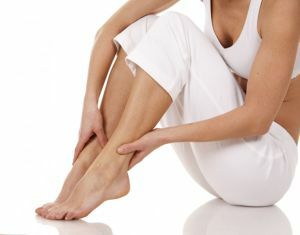
- On the of the second stage of , puffiness appears more often, and even after a long rest does not go completely. There is the appearance of pain, seizures, heaviness and rapid fatigue of the legs.
- The third stage of is irreversible when the symptoms of the previous stages progress, and loss of limb functions occurs. In this case, joints are deformed, such violations as arthrosis, arthritis and other disorders are manifested. Treatment of the disease at this stage almost does not give results.
It is important to know that the earlier a patient seeks help from specialists, the more chances for recovery.
Diagnostic features of
Most often, a specialist may notice signs of lymphovenous failure during a primary examination.
In order to confirm or deny the diagnosis, blood and urine tests are prescribed. This makes it possible to determine the presence of
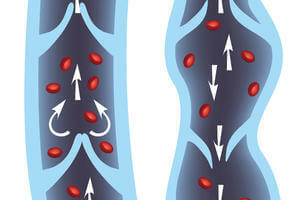
. The operation of the
valves of inflammatory processes and associated diseases is malfunctioning, and the blood viscosity is revealed by means of a general blood test.
In addition to the analysis, it is advisable to conduct an ultrasound examination. This allows you to identify the expanded and affected parts of the vessels, as well as the presence of nodes and clots.
It happens that ultrasound does not provide an opportunity to establish a complete picture of the disease and is assigned to conduct phlebography. The essence of this study is to introduce into the patient's body special substances and further monitoring the process of its progress through the veins.
Complex of therapeutic measures
The main goal of treatment of venous lymphatic insufficiency is restoration of blood circulation in the vessels of the lower limbs, normalization of outflow of blood from veins, reduction of pain and elimination of swelling.
Therapy is conducted in three directions:
- medication;
- compression therapy;
- physiotherapy and massage;
- exercise therapy.
Drug administration is prescribed for the purpose of eliminating edema, improving the outflow of lymph and reducing the fragility of small vessels. As part of therapy, the following drugs are prescribed: 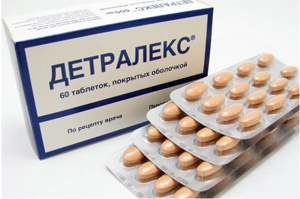
- Dicumarin;
- Diosmin;
- Detraleks;
- Flebodia 600.
Dosage and the scheme of application depends on the stage of the disease and is assigned individually.
Compression therapy
Compression therapy reduces puffiness and eliminates the feeling of heaviness in the legs.
Specialists are assigned the use of:
- elastic bandages;
- pressing elastic bandages;
- compression stockings.
Wearing special tools can improve the functioning of the venous and lymphatic systems, and also prevents stagnation of blood and promotes an even distribution of pressure.
The treatment should be carried out under the supervision of a doctor, as incorrect use of bandages can harm and worsen a patient's condition.
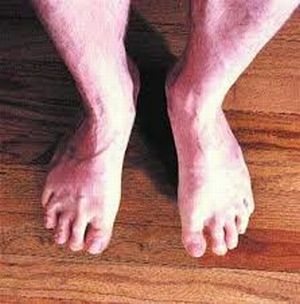 In addition to medical treatment and wearing bandages, physiotherapy is necessary. It includes measures for the care of the skin of the affected limb and the prevention of infections. Besides this, there are massages that allow to normalize the outflow of lymph.
In addition to medical treatment and wearing bandages, physiotherapy is necessary. It includes measures for the care of the skin of the affected limb and the prevention of infections. Besides this, there are massages that allow to normalize the outflow of lymph.
Patients are prescribed a set of exercises that improve the condition of the vessels in the lower limbs and restore blood circulation.
To achieve the maximum effect of the treatment, it is necessary to strictly follow the doctor's recommendations. In this case, there is a chance for a full recovery.
Especially neglected cases require surgical intervention.
Methods of Traditional Medicine
Traditional medicine offers a huge number of methods for the treatment of various diseases, including venous and lymphatic insufficiency. The most effective of them are:
- Honey with garlic .To prepare the product you need 200-300 grams of garlic and 300 grams of honey, preferably if it is liquid. Crushed garlic is added to honey, the mixture is transferred to a glass jar and infused in a cool place for 7 days. Take the drug three times a day, one tablespoon before eating for two months.

- Diuretic tea .This remedy allows to improve the processes of lymph drainage and helps to cleanse the body of toxins. Equal parts of wild rose berries and currant leaves will be needed. The ingredients are mixed and boiled with boiling water. Drinking diuretic tea should be taken before meals, about 30 minutes before eating.
- Compresses from Kalanchoe .To prepare a compress, 50 grams of Kalanchoe leaves are crushed and 0.5 liter of alcohol is poured. The drug is infused for at least 7 days in a dark place, after which it can be used for compresses.
Consequences of the disease
In the absence of adequate treatment, lymphovenous insufficiency threatens a number of complications. These include:
- disorders in the functioning of the nervous system;
- occurrence of frequent dizziness and fainting;
- rapid fatigue;
- development of cardiovascular failure;
- inflammation in the venous walls;
- appearance of blood clots.
When the thrombus is severed, the vessel is often clogged, which can lead to the death of the patient.
Preventive measures
To maintain the health of veins and prevent venous-lymphatic insufficiency, timely prevention should be done. The main preventive measures include: 
- treatment and prevention of constipation;
- moderate physical activity, exercise;
- weight control;
- precaution when taking hormonal medications;
- comfortable shoes;
- reduces loads on the feet.
Compliance with these simple guidelines will significantly reduce the risk of problems with veins.
